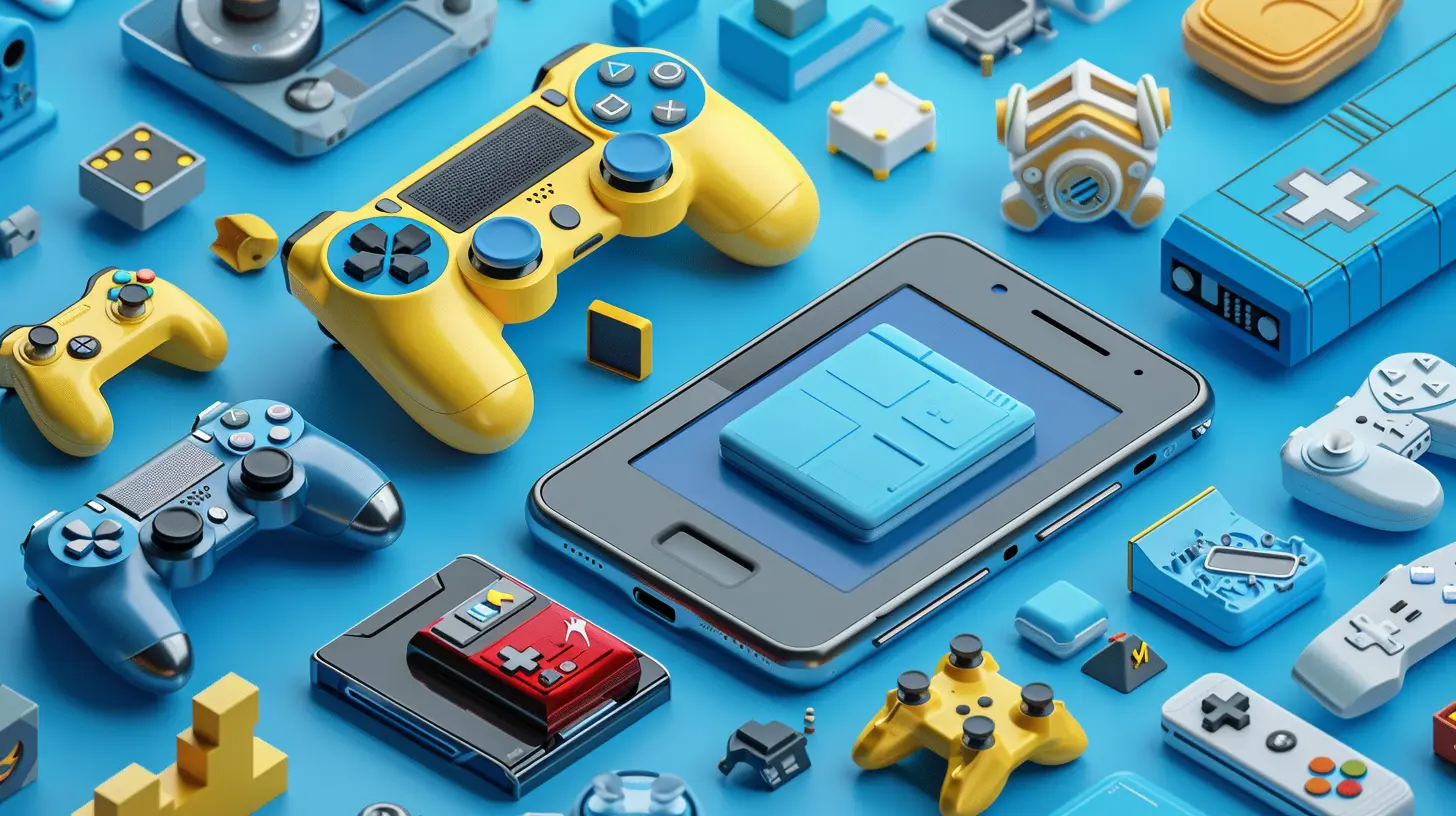The Mobile Revolution: Casual Games That Defined an Era
16 May 2025
It’s hard to imagine life without our phones, right? Whether we’re scrolling through social media, texting friends, or binge-watching cat videos, smartphones are basically glued to our palms. But let’s not forget what truly revolutionized mobile culture—the rise of casual games. Yup, I’m talking about those addictive, bite-sized games that turned bathroom breaks into epic gaming sessions and commutes into leaderboard battles.
Mobile gaming has come a long way, but there was a golden era when certain casual games absolutely defined the vibe. They weren’t just games—they were a lifestyle. So, how did we go from flipping through boring newsfeeds to frantically swiping candy-colored tiles or launching birds at snickering pigs? Let’s break it down.

What Are Casual Games, Anyway?
Before we dive into history, let’s clarify what casual games actually are. Unlike hardcore games, which require hours of commitment, intricate strategies, and advanced skills, casual games are the complete opposite. They’re simple, intuitive, and perfect for, well… casual play. Think quick rounds, easy-to-learn mechanics, and that “just one more try” appeal that keeps you hooked.And that’s what made casual games so groundbreaking—they weren’t trying to compete with AAA console titles. Instead, they catered to everyone, from gamers to your grandma who just figured out how to turn on Wi-Fi. All you needed was a smartphone, a couple of minutes, and maybe a decent dose of patience (looking at you, “Flappy Bird”).
How Mobile Gaming Took Over the World
Let’s set the stage. Picture this: it’s the mid-to-late 2000s. Smartphones are becoming more accessible. App stores pop up, creating a treasure trove of downloadable content in every category you can think of. Suddenly, mobile gaming isn’t just about playing Snake on your Nokia brick. It's a whole new ball game.The accessibility of mobile games made them explode in popularity. No expensive gaming rigs, no bulky controllers—just your trusty phone and a touch of curiosity. Developers quickly realized, “Hey, people love quick, satisfying distractions!” And before we knew it, the mobile gaming landscape was flooded with creative (and often bizarre) ideas.
Here’s the kicker: casual games weren’t just games. They became cultural phenomena. People started conversations, made memes, and even created new habits around these bite-sized digital adventures. Let’s take a nostalgic look at some of the heavy hitters that changed the game—pun totally intended.
The Pioneers: Casual Games That Changed Everything
1. Angry Birds
Who would’ve thought that throwing furious, feathered creatures at poorly-built pig fortresses could be so satisfying? Enter Angry Birds, the game that skyrocketed into mobile gaming royalty in 2009. Its premise was simple (and honestly kind of ridiculous), but that’s what made it brilliant. The slingshot mechanic was endlessly fun, the levels were challenging yet manageable, and the characters? Pure marketing gold.
Before you knew it, Angry Birds wasn’t just a game anymore—it was a brand. From plush toys to animated movies, these birds were everywhere. And let’s be real: who didn’t groan in frustration after failing a level for the tenth time, only to immediately try again? Classic.
2. Candy Crush Saga
If Angry Birds was the start of the mobile gaming revolution, Candy Crush Saga was its sustained firework show. Released in 2012, this match-three puzzle game turned every single person you knew into a candy-crushing maniac. Your aunt? Crushing candies. Your coworker? Crushing candies during meetings. Even you—don’t deny it—were secretly playing it under the dinner table.Its secret sauce? That perfect mix of colorful design, rewarding sound effects, and increasingly tough levels made it nearly impossible to put down. And let’s not forget the sneaky monetization techniques—“Need more lives? Just buy more!” Sure, it drained wallets, but it also defined how freemium games could thrive.
3. Flappy Bird
Ah, Flappy Bird. The game that almost single-handedly destroyed smartphones. Released in 2013, this painfully simple game had players tapping their screens to guide a clumsy bird through Super Mario-style pipes. Sounds easy? HA. Flappy Bird was ruthlessly difficult, and that’s exactly why it went viral.Memes, rage-inducing moments, and an endless stream of “HOW IS THIS SO HARD?!” quickly made Flappy Bird a pop culture sensation. When the creator pulled it from app stores, people were auctioning off phones with the game installed for ridiculous prices. Yep, Flappy Bird wasn’t just a game—it was a moment. A frustrating, finger-cramping moment.
4. Temple Run
Let’s switch gears for a second. Remember Temple Run? This endlessly running, treasure-hunting adventure dropped in 2011 and immediately became a fan favorite. It took inspiration from movies like Indiana Jones, threw in swipe-based mechanics, and said, “Here—run for your life.”The adrenaline rush was real. One slip of your thumb, and boom—you’re face-planting into a tree. It was the kind of game that felt equally thrilling and punishing, but you didn’t care. Why? Because you were always chasing that high score. Plus, let’s be honest—those demon monkeys were terrifying.
5. Words With Friends
Not every casual game was about swiping, tapping, or dodging obstacles. Some were about flexing your brainpower. Enter Words With Friends, a digital spin on Scrabble that let you challenge your friends (or random strangers) to word-building battles.Released in 2009, Words With Friends scratched that competitive itch without being overly complicated. Its social aspect was a game-changer, too—what’s better than passive-aggressively crushing your bestie with a 50-point word? It wasn’t just gaming; it was bonding. Or, in some cases, a friendship-ending grudge.
Why These Games Stuck Around
So, what made these games so iconic? It wasn’t just luck (though that definitely played a role). These games nailed a few key elements:- Simplicity: Anyone could pick them up and play. No tutorial videos required.
- Accessibility: Available for free (or cheap) on any smartphone.
- Addictiveness: Each game had that “one more round” vibe.
- Social Connection: Some games encouraged friendly competition, while others sparked widespread conversations and memes.
The result? A perfect storm that turned pocket-sized time fillers into global sensations.
Casual Games Today: The Legacy Continues
Fast-forward to today, and casual games are still thriving. Sure, the industry has pivoted to more complex games (hello, Genshin Impact), but the core spirit of casual gaming remains alive and well. Newer titles like Among Us and Clash Royale owe a debt to those early trailblazers, proving that sometimes, less is more.And let’s not overlook how casual games changed the tech industry. They set the stage for app monetization models, influenced smartphone design (bigger screens, faster processors), and even normalized microtransactions (for better or worse).
Final Thoughts: Why Casual Games Matter
At the end of the day, casual games weren’t just about killing time—they were about bringing people together and giving us small moments of joy. They transformed the way we think about gaming and showed us that you don’t need a fancy console or tons of free time to have fun. Whether it’s swiping through candies, flinging birds, or running from demon monkeys, these games reminded us of one simple truth: gaming is for everyone.all images in this post were generated using AI tools
Category:
Casual GamesAuthor:

Stephanie Abbott
Discussion
rate this article
4 comments
Phoebe Reyes
Great insights! Casual games truly transformed mobile gaming's landscape and accessibility.
May 25, 2025 at 5:17 PM

Stephanie Abbott
Thank you! I'm glad you enjoyed the article. Casual games have indeed reshaped the mobile gaming landscape and made it more accessible for everyone.
Sari Williams
Casual games transformed our downtime into fun adventures! Nostalgic for those simple, addictive moments. What a journey!
May 25, 2025 at 3:57 AM

Stephanie Abbott
Thank you for your thoughts! It's amazing how casual games have shaped our experiences and created lasting memories. Cheers to those fun adventures!
Noora Lee
Ah, the nostalgia! Casual games introduced the perfect blend of fun and accessibility. Whether it was Candy Crush or Angry Birds, these gems turned waiting rooms into thrilling adventures for everyone. Classic memories!
May 24, 2025 at 3:32 PM

Stephanie Abbott
Absolutely! Casual games like Candy Crush and Angry Birds revolutionized mobile gaming, making it accessible and fun for all. They truly created lasting memories in everyday moments!
Asher Wilkerson
Casual games: the ultimate excuse for pretending to work while frantically slaying candy or racing cartoon cars! Who knew that saving a kingdom from pixelated doom could also save us from adulting? Cheers to the mobile revolution—where productivity goes to take a coffee break!
May 20, 2025 at 1:31 PM

Stephanie Abbott
Absolutely! Casual games truly provide a delightful escape from the daily grind, blending fun with clever distractions. Cheers to gaming!



